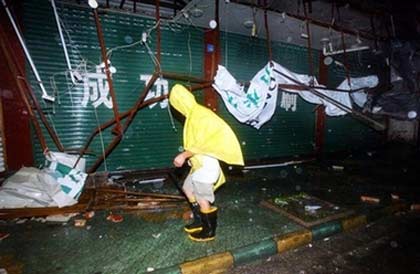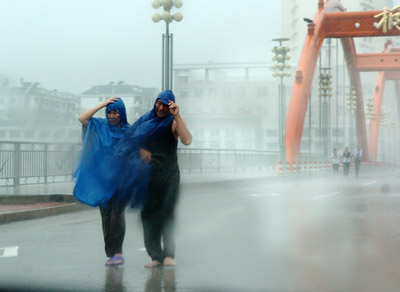The most powerful typhoon to hit China in five decades raged across the
southeastern coast Thursday, claiming at least 111 lives as it capsized ships,
destroyed buildings and forced 1.5 million people from their homes.

A man walks by billboards blown down by strong
winds as Typhoon Saomai whips Cangnan county in east China's Zhejiang
province, August 10, 2006. [AP Photo] |
Typhoon Saomai, with winds up to 135 mph, made landfall at the town of Mazhan
in coastal Zhejiang province, the Xinhua News Agency said, citing weather
officials.
The death toll was put at two Thursday as the storm raged, but it quickly
rose Friday with recovery efforts under way and had reached 111 by midday,
according to Xinhua.
Most of the deaths occurred in Zhejiang province, where the bodies of 43
people, including eight children, were discovered in Cangnan county amid the
debris of collapsed houses, Xinhua said.
Eighty-one people were killed in the southeastern Zhejiang city of Wenzhou,
Xinhua said. It did not give any details, but the bodies of 43 people, including
eight children, were discovered in Wenzhou amid the debris of collapsed houses.
Another 28 people were killed and 11 missing in other parts of Zhejiang. In
neighboring Fujian province, two people were killed.
Officials said at least 80 people were injured across the region. The typhoon
was also blamed for at least two deaths in the Philippines earlier.
Torrential rains were forecast in the next three days as the typhoon churned
inland across crowded areas where Tropical Storm Bilis killed more than 600
people last month.
Eight sailors from were missing after two ships capsized in a harbor in
Fujian, while four from the mainland were missing after their ship
struck a reef, the agency reported. Seven others were reported missing in the
Philippines after giant waves and heavy rains generated by the typhoon battered
coastal villages, officials said.
Saomai, dubbed a "super typhoon" by Chinese forecasters due to its huge size
and high wind speeds, was the eighth major storm of this year's unusually
violent typhoon season. Saomai was the most powerful typhoon to hit China
since 1949, Xinhua said, citing the Zhejiang provincial weather bureau.
Before the storm's arrival, 990,000 people were evacuated from flood-prone
areas of Zhejiang and 569,000 from the neighboring coastal province of Fujian,
Xinhua said. It said a total of 70,000 ships had returned to port in the two
provinces.
The area is about 950 miles south of Beijing, the Chinese capital, which was
not affected by the storm.
|

Two local residents manage their way amid
heavy rains in Fuding County, east China's Fujian Province Thursday,
August 10, 2006, as typhoon Saomai, the strongest typhoon in 50 years,
made landfall in east China. [Xinhua]
|
In the Philippines, more than 200 houses built on stilts were destroyed and a
child was killed and another was reported missing as waves up to 10 feet tall
ravaged the coast of Bongao, the capital of southern Tawi-Tawi province, before
dawn Wednesday, provincial Gov. Sadikul Sahali said.
"There is floating debris everywhere," Sahali said.
At least six members of a family also were reported missing after their house
was buried in a landslide on Sarangani island, part of southern Davao del Sur
province, the Office of Civil Defense said.
Elsewhere, a man was killed as big waves washed away about 200 shanties in
seaside villages in Talisay city on central Cebu island early Wednesday, the
civil defense office said.
Saomai, named for the Vietnamese word for the planet Venus, passed across
Japan's Okinawa island group on Wednesday with winds up to 89 mph, prompting
airlines to cancel 141 flights and affecting 24,000 passengers.
China's weather bureau had forecast unusually heavy typhoon action this
summer, saying warmer than normal Pacific currents and weather patterns over
Tibet would create bigger storms and draw them farther inland.
Bilis triggered flooding and landslides as far inland as Hunan province,
hundreds of miles from the coast.
Most of the deaths happened in areas away from coastal communities that have
elaborate dike networks and a long history of evacuating flood-prone areas.
Typhoon Prapiroon lashed China's southern coast last week, killing at least
80 people in floods and landslides in Guangdong province and neighboring
Guangxi.
Even as Saomai stormed ashore, Chinese forecasters were already closely
watching Tropical Storm Bopha, which trailed behind it farther out in the
Pacific. Bopha was about 110 miles southeast of Guangdong late Thursday and
moving west with winds of 29 mph, according to the Hong Kong
Observatory.